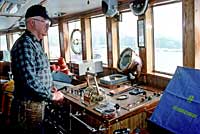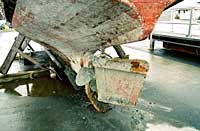Lower Your Fuel Costs
TIPS AT A GLANCE
- Slow down.
- Look at your exhaust.
- Check your prop.
- Maintain the bottom of your boat.
- Rethink your electrical system.
- Check your steering.
- Plan your route and timing.
- Reduce vessel weight.
- Keep good records.
- Do the math.
Also see section 6, "Energy Conservation Ideas (ECIs)," and section 7, "No-Cost and Low-Cost Energy Conservation Opportunities (ECOs)," in the Fuel Efficiency Audit Worksheet [PDF; 160 KB].
Terry Johnson, Alaska Sea Grant Marine Advisory Program

Photo by Kurt Byers.
Increased fuel prices are hurting commercial fishermen and charter boat operators. Saving fuel is a complex and personal issue, dependent largely on your particular vessel and how you operate. Here are tips to consider for lowering your vessel fuel costs.
1. Slow down. In a displacement vessel, even a small decrease in boat speed will save fuel. Data show that reducing power as little as 10% from full throttle will save 20%. But there's more—the biggest power drain comes in making the bow and stern wave that every displacement boat drags along. Back off the throttle to the point where those waves start to flatten out, and the savings will be greater. Cutting speed by one to two knots can cut consumption by 30% to 50%.

Photo by Kurt Byers.
Diesel engines are most efficient at 80% of maximum continuous rating (MCR). That means they produce the most power for the fuel consumed. Most fishing vessels are over-powered—they achieve most efficient vessel speed at a power setting well below optimum engine speed and load. To get the most nautical miles per gallon you'll probably have to run your engine at a speed slower than its most efficient setting. Too slow for too long, however, could damage your engine.
If yours is a planing or semi-displacement hull, the matter is more complicated. Slowing too much can decrease fuel efficiency. Use a fuel flow meter, or keep accurate records of gallons burned divided by miles traveled at different rpms until you find the most efficient engine and boat speed for your vessel.
2. Look at your exhaust. Exhaust from a well-maintained diesel engine is virtually invisible. If yours is black, the engine is overloaded, starved for combustion air, or has worn injectors. If it is white, there is an injector or valve timing problem, burnt valves, or bad gaskets allowing coolant into the cylinders. If exhaust is blue, there is oil in the combustion chambers from worn rings or valve guides or a turbo seal failure. All of these problems decrease engine efficiency and increase fuel consumption.

Photo by Kurt Byers.
3. Check your prop. When the boat is out of the water, check the prop for bent blades, dings, or eroded edges that indicate cavitation. These are fuel-robbers and should be repaired.
While underway, check the propwash for excess turbulence and bubbles that suggest a prop that's too small or has too little pitch. And check your exhaust stack for black smoke that would suggest overloading (see #2 above).
Use your tachometer and pyrometer to ensure you have the right prop. This can change as the use of the boat changes or it gains weight or resistance (see below) from additional equipment or modifications. The engine should quickly reach rated rpms and exhaust temperature should be within manufacturer's specs; if not, the prop is too big or has too much pitch. If the engine exceeds rated speed or exhaust temperature is too low, you may not be wasting fuel but you could be causing long-term harm to the engine due to carboning and cylinder glazing.
Use a computer prop sizing service to ensure you have the right diameter, pitch, blade area, and prop configuration.

Photo by Kurt Byers.
4. Maintain the bottom. Marine growth on the bottom of your boat saps power and wastes fuel. Get the weeds and barnacles off and keep them off with proper antifouling paint. The smoother the paint, the less skin friction, so find the right paint for your hull.
Sponsons, struts, sea chests, keel coolers, transducers, and stabilizers all increase hull drag. You probably need those more than an extra fraction of a mile per gallon, but if there's something below the waterline you don't need, get rid of it.
5. Rethink your electrical system. Do you need to run a diesel genset around the clock or can you use batteries and an inverter for your "hotel" power? A larger alternator on an underloaded main engine may produce electricity more efficiently than a standalone generator. Can you cook on an oil or propane range rather than an electric one? Consider adding a wind charger or solar panels to reduce the fuel cost of electricity.
6. Check your steering. If your boat is not going the shortest distance to your destination, you're wasting fuel. If there's play in your steering, adjust it to eliminate as much as possible.
A good autopilot can steer straighter than any helmsman. Even if you have a great autopilot, watch your wake and you may see that you're zigzagging through the water. The pilot's control head probably has adjustments that change steering parameters and allow you to minimize delayed or oversteering in calm conditions. Modern units even have a "no-drift mode" that compensates for wind and current.

Photo by Kurt Byers.
7. Plan your route and timing. Remember when vessels used to depart "on the tide"? It was not so necessary with big engines and cheap fuel, but now routing to take advantage of tides, currents, and predicted winds can save money. Remember, the shortest distance between two points on the water is not necessarily a straight line. Tide and current tables, and oceanographic current charts, can indicate ways to get a boost from nature. Good weather forecasts can help you avoid headwinds or delaying sea conditions, and also suggest chances to get a boost from tailwinds.
8. Reduce vessel weight. More important on a planing or semi-displacement vessel, weight control reduces the amount of power needed to achieve a given speed. Boats quickly fill up with supplies, gear, and spare parts. On short trips or openings, it may not be necessary to run with full fuel and water tanks. Use trim tabs or shift passengers, gear, and ballast to achieve proper vessel trim.
On displacement boats, however, additional weight may improve seakeeping and in some cases may actually improve fuel efficiency by helping the boat proceed more directly through the water. Each case is different.

Photo by Kurt Byers.
9. Keep good records. You only know whether you're making an improvement (or making things worse) if you have good numbers on vessel performance, both before and after changes. At every fuel-up you should record fuel replaced, operating hours (from your hour meter or engine hour logbook), and if possible, distance traveled. Other observations such as changes in coolant and exhaust temperatures, oil temperatures and pressures, and speed over the ground (as indicated by GPS or LORAN readings) should be logged.
10. Do the math. Fuel is only one of the costs of your operation. Capital expenditure (the price of new equipment) and the value of your time and that of your crew are also costs. The cost of a solution, such as buying a new engine or even a new vessel, may be greater than the savings that could be realized. As fish prices, fuel costs, regulations, and other factors change, it is important to recalculate the trade-offs.


